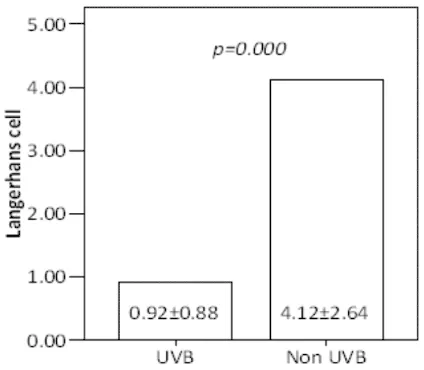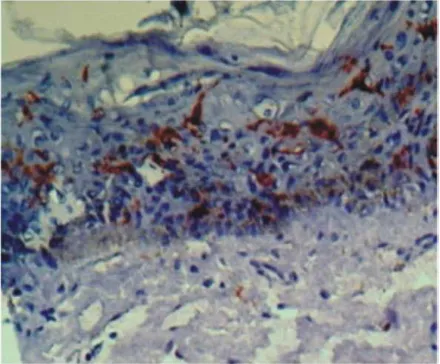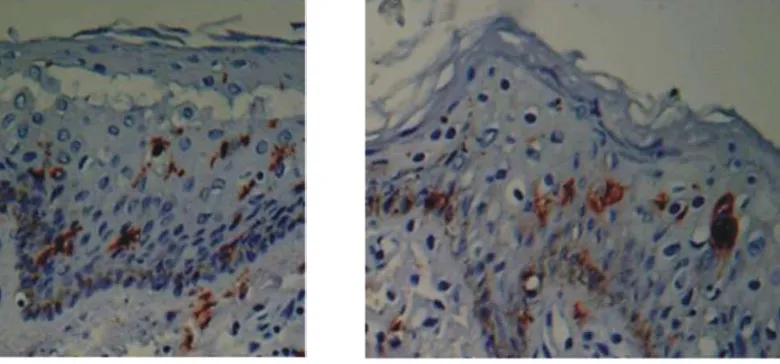The protective effect of sunscreens against
ultraviolet B-induced immunosuppression.
A study on Langerhans cell depletion
Flora Ramona SP., Fajar Waskito, Yohanes Widodo Wirohadidjojo*
Department of Dermatovenereology, Faculty of Medicine
Gadjah Mada University / Dr. Sardjito Hospital Yogyakarta, Indonesia
ABSTRACT
Ultraviolet B (UVB) radiation can act as immunosuppressant by inducing an epidermal Langerhans cells (LC) depletion which could be inhibited by topical sunscreen. Several kinds of sunscreens with various SPF (Sunscreen Protection Factor) are now available. The minimal SPF which able to inhibit the immunosuppressive effect of UVB among people with skin photo-type IV has not been established yet. The aim of this study is to determine the minimal SPF capable to inhibit UVB-induced immunosuppression among people with skin photo-type IV. A simple experimental (post test only experimental) study was conducted among 5 people’s circumsized foreskins with Fitzpatrick’s skin photo-type IV. Each of them was divided into equal 5 pieces of 0.5 cm2. Each of three pieces of skin was treated by sunscreen SPF 15, SPF 30, and SPF 50, a single piece of skin was treated with placebo, and all of them then were treated by a single 100 mJ/cm2of UVB 30 minutes later. A rest single piece of skin was used as control. After 24 hours of incubation in incubator of 37OC and 5% CO
2, all of them then was fixed by buffer formalin, blocked by paraffin, cut in 2 mm of thickness, and then stained with anti CD 1aantibody with AEC as chromogen and Mayer’s hematoxylin as counterstaining. The number of LC was counted byImage J Analysisprogrammed and the mean of LC were analyzed by Kruskal-Wallis test dan Mann-Whitney test. There were very significantly different of the mean number of LC between UVB placebo group and control group (p < 0.01). Compared to the control group, mean number of LC among SPF 30 and SPF 50 treated groups were not significantly different (p > 0.05). Sunscreen with SPF 15 had LC number lower than control group significantly (p < 0.05). The lowest SPF for preventing UVB induced LC depletion among people with skin photo-type IV was 30.
Key words: UVB - immunosupression – sunscreens – SPF -CD1aexpression
INTRODUCTION
The suppressive effect of ultraviolet B (UVB) radiation on the human immune system has been revealed over the last four decades. Kripke and Morison1stated that the suspicion against the UVB immunosuppression effect began since Hanisko and Suskind (1963) reported the fact of less severity contact allergic reaction among guinea pigs exposed to UVB compared with control. Toews et al2. reported an inhibition of contact hypersensitivity reaction among skin C57BL mice exposed to UVB. In addition similar reaction was also occurred among human skin exposed to UVB.3The supporting data can be observed in the reactivation and replication of herpes simplex virus (HSV) due to UVB
exposure.4The main point of UVB radiation is on the induction of LC migration from epidermis.5,6 and can reduced the ability of LC to recognize antigens and present them to T cell.7
It is known that sunscreen is not only capable to protect human skin against sunburn but also it can prevent the formation of actinic keratoses8,9and possibly squamous cell carcinoma.9 Sunscreen protective effect against the Langerhans cell (LC) depletion has been reported by several researchers. Research by Horchberg and Enk10, Israelet al11.in Austria showed that sunscreen with the low-moderate SPF categories (SPF 2-16) can inhibit depletion of LC partially on healthy adult skin phototype II and III.
Differs with those researches, Indonesian people are dominated by Fitzpatrick’s skin photo-type IV. The minimum SPF required to inhibit the immunosuppressive effect of UVB on skin photo-type IV has not been recommended yet. The aim of this study was to determine the minimum SPF that can provide immunoprotection for Indonesian people who are dominated by photo-type IV skin based on sunscreen’s ability in inhibiting UVB-induced LC depletion.
MATERIALS AND METHODS
A simple experimental study was performed among 5 foreskins collected from circumcision. Each foreskin was cut into 5 pieces of 0.5 cm2and they were divided randomly to be (UVB + placebo) group, (UVB + sunscreens SPF 15, 30, 50) group, and control (Non UVB) group. Sunscreens (4 mg/ cm2) were applied on the epidermal side of skin. After 30 minutes, UVB radiation was performed at 100-mJs/cm2. The skin explant was cultured in RPMI complete medium with air interface of epidermal sides in 0.5 uM filter surrounded by metal rings (FIGURE 1).
FIGURE 1. Skin organ culture
Tissue fixation, paraffin blocking, and cutting were performed 24 hours later. Histological images were captured digitally by using 8 mega pixels camera connected to ocular lens of 400 magnification light microscope (Olympus) in quadruplets for each histological slide.
FIGURE 2. The figure showed depletion of Langerhans cell induced by UVB. The mean number of Langerhans cells of
placebo (UVB) group was very significantly different compared to control (Non UVB) group (p < 0.001)
Measurement of CD1anumber was based on the cell counter of the program ImageJ analysis. Data which were unnormal distributed were analyzed using Kruskall-Wallis with post hoc test by Mann Whitney.
The study has been approved by the Health Research Ethics Committee of the Faculty of Medicine, Gadjah Mada University, Yogyakarta.
RESULTS
FIGURE 3. The figure shows the protection against depletion of Langerhans cell induced by UVB offered by sunscreens.
The mean number of Langerhans cell of placebo (UVB) group was significantly different compared to sunscreen
treated group (p<0,05)
FIGURE 4. The figure showed that sunscreen with SPF 15 had Langerhans cell number lower than control group significantly (p < 0.05). Compared to the control group, the mean number of Langerhans cell among SPF 30 and SPF 50
treated groups were not significantly differ (p > 0,05) .
FIGURE 5c. UVB exposure with sunscreen SPF 15 FIGURE 5a. Non UVB (control)
FIGURE 5d. UVB exposure with sunscreen SPF 30
FIGURE 5. Results of epidermal staining of Langerhans cells
FIGURE 5e. UVB exposure with sunscreen SPF 50
DISCUSSION
Based on FIGURE 2, the mean number of LCs in the placebo (UVB) group was very significantly different (p < 0.001) compared to control (Non-UVB) group, indicating that the wavelength and amount of UVB energy used in this study induced the depletion of LC. This finding was in accordance with several studies that reported that UVB causes depletion3,5and morphologic changes of LC.5The depletion of LC number was due to the LC migration that induced by UVB.6Miyagiet al12.reported that exposure to UVB of 100 mJ/cm2dose can induce migration of LC. The migration occurred after 24 hours of exposure to UVB.13,14 In this study, the skin was exposed to 100 mJ/cm2dose of UVB and incubated for 24 hours. Ghaznawie15 stated that depletion of LC and changes in LC morphoplogy would affect LC function and eventually influence the cutaneous immune response.
FIGURE 3 showed a significant difference in the mean number of LC of placebo (UVB) group compared to sunscreen treated group. It was in accordance with other researches which revealed the protection against depletion of Langerhans cell induced by UVB was offered by sunscreens, both in animal16,17and human.4,18 Elmetset al19. stated that both the cinnamate and benzophenone sunscreen combination and an extract of baker’s
yeast present in the preparation had photoprotective properties. Pretreatment of skin with one such cosmetic product provided complete protection against UV-induced erythema, sunburn cell formation and Langerhans cell damage in volunteers, skin photo-types II and III.19Hoet al20. showed the ability of sunscreen contains octyl dimethyl para-aminobenzoate (Padimate O), 2-ethylhexyl-p-methoxycinnamate (2-EHMC), and benzophenone could protect LC, inhibited UV light from depleting LC from the epidermis of mouse. Walkeret al25. reported that the UVB sunscreen 2-ethylhexyl-4-methoxycinnamate had ability to inhibit LC depletion in hairless albino mouse.
In this study we used skin organ culture model. Organ culture is a technique whereby small, undisaggregated tissue are cultured at an air-liquid interphase, so that they can retain a three dimensional structure and some or all of the histological and functional feature of the tissuein vivo. This technicque has provided many advantages including superior control of the physicochemical environment and physiological conditions. Furthermore, they provide more ethical and cheaper alternative toin vivostudies.24Unfortunately, organ culture can bring with them a number of problems which can severely limit their usefulness such as reproducibility between cultures can be poor, especially if more than one donor was used. To solve the problem, it is necessary to perform further study to investigate the immunoprotection effect of the same sunscreens against UVB induced LC depletionin vivomodel with a larger sample size.
CONCLUSION
This study showed that the lowest SPF for preventing UVB induced LC depletion in skin organ culture of Indonesian people with skin photo-type IV is 30 inin vitromodel.
ACKNOWLEDGMENT
Authors would like to thank Director of Dermato-venerology of Faculty of Medicine, Gadjah Mada University/Dr. Sardjito Hospital for the laboratory facilities.
REFERENCES
1. Kripke ML, Morison WL. Modulation of immune function by UV radiation. J Invest Dermatol 1985; 62-6.
2. Toews GB, Bergsteer PR, Streilein JW. Epidermal
langerhans cell density determines whether contact hypersensitivity or unresponsiveness follows skin painting with DNFB. J Immunol 1980;124: 446-53.
3. Cooper KD, Oberhelman L, Hamilton TA, Baadsgaard O, Terhune M, LeVee G. et al. UV exposure reduces immunization rates and promotes tolerance to epicutaneous antigens in humans: relationship to dose,
Cd1a-Dr+ epidermal macrophage induction, and
langerhans cell depletion. Nat Acad Sci 1992; 89: 8497-501.
4. Rooney JF, Bryson Y. Prevention of ultraviolet-light-induced herpes labialis by sunscreen. Lancet 1991;338: 1419-22.
5. Aberer W, Schuler G, Stingl G, Honigsmann H, Wolff K. Ultraviolet light depletes surface markers of Langerhans cells. J Invest Dermatol 1981;76: 202-10.
6. Stoitzner P, Pfaller K, Stossel H, Romani N. A close-up view of migrating langerhans cells in the skin. J Invest Dermatol 2002;118: 117-25.
7. Bergsteer PR, Toews GB, Streilein JW. Epidermal
Langerhans cell density determines whether contact hypersensitivity or unresponsiveness follows skin painting with DNFB. J Immunol 1980;24(1): 445-52.
8. Thompson SC, Jolley D, Marks R. Reduction of solar keratosis by regular sunscreen use. New Engl J Med 1993;329: 1147-51.
9. Green A, William G, Neale R, Hart V, Leslie D, Parsons P, et al. Daily sunscreen application and betacarotene supplementation inprevention of basal-cell and squamous-cell carcinomas of the skin: a randomised controlled trial. Lancet 1999;354: 723-29.
10. Hochberg M, Enk CD. Partial protection against epidermal IL-10 transcription and langerhans cell depletion by sunscreens after exposure of human skin to UVB. Photochemist Photobiol 1999;70: 776-82.
11. Hofmann-Wellenhoff R, Smolle J, Roschger A, Strunk D, Hubmer M, Hoffmann C, et al. Sunburn cell formation, dendritic cell migration, and immunomodulatory factor production after solar-simulated irradiation of sunscreen-treated human skin explant in vitro. J Invest Dermatol 2004;123: 781-7.
12. Miyagi M, Bhutto AM, Nonaka S. The effects of
sunscreens on UVB erythema and langerhans cells depression. J Dermatol 1994;21 (9): 645-51.
13. Richters CD, Reits EAJ, Van Pelt AM, Hoekstra MJ, Baare JV, Dupont JS, et al. Effect of low UVB irrad iation on the migratory properties and functional capacities of human skin dendritic cells. Clin Exp Immunol 1996;104: 191-7.
14. Kremer IB, Regien MR, Steendland S, Bos JD, Teunissen BM. Despite the presence of UVB-induced DNA damage, HLA-DR+ cells from ex vivo UVB-exposed human skin are able to migrate and show no impaired allostimullatory capacity. J Invest Dermatol 1997;109: 626-31.
15. Ghaznawie M. The kinetic of murine epidermal
Langerhans cells. Thesis for The Degree of Doctor of Philosophy of the University of Western Australia. 1995. 16. Wulff HC, Poulsen T, Brodthagen H. Sunscreen for delay of ultraviolet induction of skin tumor. J Am Acad Dermatol 1982;7: 194-202.
17. Van Der Molen R, Garssen J, Klerk AD, Claas FHJ, Norval M, Loveren H, et al. Application of systemic herpes simplex virus type 1 infection in the rats as tool for sunscreen photoimunoprotection studies. Photochem Photobiol Sci 2002;1: 592-6.
18. Rosen FC. Topical and systemic photoprotection.
Dermatol Ther 2003;16: 8-15.
20. Ho K, Halliday G, Barnettson R. Sunscreen protect epidermal Langerhans cells and Thy-1+ cells but not local contact sensitization from the effect of ultra light. J Invest Dermatol 1992; 98(5): 720-4.
21. Walker SL, Morris J, Chu AC, Young AR. Relationship between the abilityof sunscreens containing 2-ethylhexyl-4’-methoxycinnamate to protect against UVR-induced inflammation, depletion of epidermal Langerhans (Ia+)
cells and suppression of alloactivating capacity of murine skin in vivo. J Photochemist Photobiol 1994;22: 29-36.
22. Van der Pols JC, Williams GM, Pandeya N, Logan V, Green AC. Cancer Epidemiol Biomarkers 2006;15(12): 2546–48.
23. Edwards EK Jr, Frank BL, Rosen LB. The effect of an ultraprotective sunscreen on langerhans cell alteration induced by ultraviolet light in human skin. Pharmacol Ther 1986; 327-29.
24. Shaw AJ. 2002. Modelling epithelial tissues in vitro. In: Epithelial cell culture. A practical approach, 2ndeds. New


